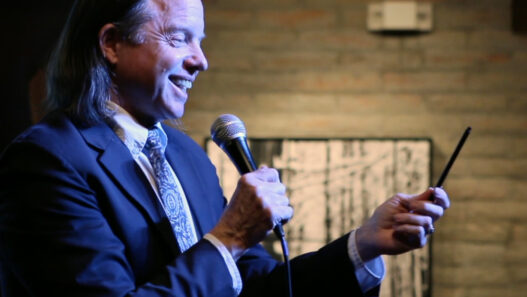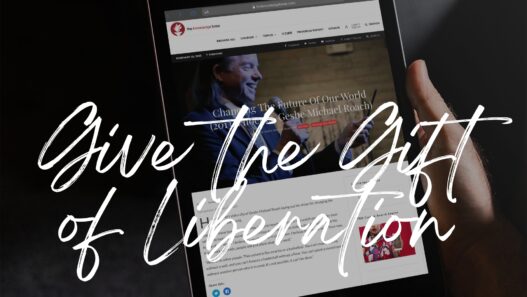Class 1: Where the Steps Have Taken Us
Welcome to the lam rim (LAM RIM) retreat—the Steps of the Path to Liberation. I’d like to welcome Stanley Chen my translator, thank you for coming, and thank you for translating over and over.
[su_icon icon=”icon: link” color=”#ff1259″ size=”20″ shape_size=”12″ url=”https://www.youtube.com/watch?v=VAtY8mi3sVs&t=19s” target=”blank”]Jump to this place in the video[/su_icon]So, as you probably know, this is our 35th Steps to the Path retreat, and we are going through one of the greatest books, in my opinion, ever written in this world. It’s called A Gift of Liberation Put in Your Hand, and it’s a beautiful idea that if you study this book, and if you read this book, then it’s like somebody just coming and giving you freedom—liberation.
So, this time we’re going to be doing this retreat at home because of the virus situation around the world, and I think it might even be better. Each day we’re going to do about half an hour of filming, and it will go for 25 days. And I think it’ll be a great format for all of us, and we’ll also be doing meditations together during that time. Each segment, each day, is going to have its own name and each segment will have its own ideas behind it. And each segment has its own main image or picture. So, what you see here in the picture are steps going into the sky and there’s a door in the sky.
[su_icon icon=”icon: link” color=”#ff1259″ size=”20″ shape_size=”12″ url=”https://www.youtube.com/watch?v=VAtY8mi3sVs&t=2m56s” target=”blank”]Jump to this place in the video [/su_icon]And that’s the meaning of the word lam rim. I like to think of it like when you buy a piece of furniture from Ikea. You get a paper and it says: first do this, then do that, then do that. And you don’t have to think too much; you just do the first thing. Hook these two things together, then okay what’s the second thing? It says, “screw the screw here,” then you just … it’s for dummies, and you don’t think about the chair you’re making; you just do those instructions one-by-one.
I don’t know about you, but I get scared when I buy that furniture that I have to put together. I look at all the papers and all the screws, and I think, “Oh, I’m going to fail!” And in my long life what I learned is: just shut up, open the box, get the instruction book; don’t look at the whole thing, don’t look at all the parts, just look at the first sentence.
Put this screw in this hole. And then I do that and I feel okay. Then I say, “Okay, I’m ready for the second one.” And then, if I just take it piece-by-piece, step-by-step, and I don’t worry too much really about what I’m going get at the end, then suddenly the last screw went in and suddenly I have a beautiful chair.
My partner, Veronica, says, “Oh you’re so smart!” And actually I’m not smart, I’m stupid. I just do one-by-one. So, lam rim is the same; just do the steps, dummy, one-by-one. Then suddenly one day, you look down and you don’t have a chair, you have a Buddha body. Then, like “Oh, I’m done!” So, think like that. Just take the steps one-by-one. Enjoy each step. Focus on each step. And then by the end you’re a Buddha and you didn’t have to do anything.
[su_icon icon=”icon: link” color=”#ff1259″ size=”20″ shape_size=”12″ url=”https://www.youtube.com/watch?v=VAtY8mi3sVs&t=6m22s” target=”blank”] Jump to this place in the video [/su_icon]Okay, so we started these retreats in 2010—usually 7 to 10 days and oftentimes we went to Diamond Mountain Retreat Center, and more recently to other countries. We have a very pleasant annual retreat in the summer in Guadalajara, Mexico, and nowadays we have a special retreat in Bali each year around December. Jasmine Yao from Guangzhou and her team, they have like 700 people come to a beautiful hotel and we enjoy swimming in the ocean.
So, we’ll still be doing those retreats. If the virus has settled down by July, we’ll see you in Mexico—very beautiful place. And then in December, we’ll see you in in Bali. In October, we’ll do a special retreat at Diamond Mountain in Arizona, in America.
So, each time we do a retreat, at the beginning, I’d like to tell you how far did we go, and how far we have to go. And I can see from how fast we are going. And by the way, I am purposely not going fast. They say when you drink an old wine, I don’t drink wine, but you should drink it slow, enjoy the taste, swish it around in your mouth, and then swallow.
So, I want to study the steps of the path like that. We are going slow. In English, we say we are savoring the taste, we are enjoying the taste. We are stopping often, many times, to go deeper. And in some of these sessions, we’ll just do a meditation the whole time. My dream is that these teachings on the steps to the path, the total plan is going to take 23 years. We’ve already finished 10 years, and my total plan is 13 more years. If we go on schedule we will finish in 2039 and I will be 87 years old. Stanley will be 20 I think. Just kidding!
[su_icon icon=”icon: link” color=”#ff1259″ size=”20″ shape_size=”12″ url=”https://www.youtube.com/watch?v=VAtY8mi3sVs&t=10m13s” target=”blank”] Jump to this place in the video [/su_icon]So, in my feeling, in my opinion, I want these teachings to be part of your whole life; so 23 years, it’s a big part of anybody’s adult life, and my dream is that you have this support in your life for 23 years. And every year, three or four times, you’ll have the opportunity to go to another retreat if you want in-person, but we also broadcast them for free. We might ask you to help with the cost of the airplane if you have to come there, or the hotel cost, or the cost of these cameras and all of this equipment, but there’s no charge for the teaching. And so for 23 years, I want you to just enjoy these classes and I think it will be a foundation for your life.
My teacher took 30 years. He taught it twice in 30 years. And for me, it gave me a foundation for the happiness of my life. Okay, it’s the 35th retreat now; we’ll finish this book after 50 retreats.
Then this book has a sister book, which is called The Great Steps on the Path, by Je Tsongkapa; actually that lam rim was written before this lam rim, and when that steps to the path reached the last two of the six perfections, which is meditation and emptiness, then Tsongkapa … there’s a story, he had trouble writing it.
And he started, but he wasn’t doing a very good job. And then he prayed to Manjushri, the Angel of wisdom, and then he was able to finish the section about meditation and emptiness. And it’s something like 200 pages—so for dessert, after we’ve finished the fifty retreats, let’s do another forty retreats about this great, great presentation of meditation—how to meditate and how to see emptiness.
[su_icon icon=”icon: link” color=”#ff1259″ size=”20″ shape_size=”12″ url=”https://www.youtube.com/watch?v=VAtY8mi3sVs&t=14m20s” target=”blank”] Jump to this place in the video [/su_icon]So, that’s our plan. Your life will go through many changes during this 33 years total. Your life will go through many changes; sometimes you might be very interested in these retreats. You will travel to Mexico, or to Bali, or America to see those retreats, and then sometimes your family life, or your business life, or your personal emotions will change for a few years. And maybe you will just watch them on the video, or maybe you will decide you’re too busy to watch them, but our plan—ACI’s plan—we will video everything. You’ll have 33 years of videos, and when you’re ready, any time you want, you can go on the ACI website and you can you can access these videos.
So, don’t don’t worry too much about it. If you feel very interested, then fly to where the retreat is being held; if you’re busy, then watch it online. If you’re super busy, save it for later, but our commitment is that in your life you will have these many years of teachings. They will be ready for you anytime you’re ready. In my experience, when people get a serious illness like cancer, or something happens big in their life, like their their husband or wife passes away, then they need support and these videos on the steps in the path, they will be waiting for you when you’re ready. They’ll be here and we make that commitment to you. Okay?
[su_icon icon=”icon: link” color=”#ff1259″ size=”20″ shape_size=”12″ url=”https://www.youtube.com/watch?v=VAtY8mi3sVs&t=17m20s” target=”blank”] Jump to this place in the video [/su_icon]Alright, so let’s talk about the big divisions, or the big parts, we’ve already finished in these last ten years. The steps of the path are divided into three big divisions. The short name is kye bu chung (SKYES BU CHUNG), kye bu dring (SKYES BU ‘BRING), and sky bu chenpo (SKYES BU CHEN PO).
Kye bu chung means “the teachings for people of lowest capacity.” And the lowest capacity person in the lam rim is somebody who’s worried if they are going to go down after they die. And right now, maybe you’re not worried about it, but if something happens to you—if you get a serious disease, or you get into an accident of some kind, it will become the most important thing in your life. Like, “Where am I going after this? How can I get some insurance that I won’t go down?” So, that motivation, or that capacity, literally it’s called a “small person.”
Then a medium person … and we finished that. And if you didn’t hear those early retreats,you can find them online. We’ll put up all the links for you. The second big section is called “medium people.” Medium motivation. And these people are like, “Even if I’m reborn, even if I don’t go down as an animal, if I’m born as a human it’s so much trouble. I would like to reach Nirvana, and then I don’t have to go back to a life full of problems.
Getting older and older, my body falling apart, losing my family. I don’t even want to go through a human life again, I would like to find …”you can say a human life, but one … we call it Arhat, or someone who reached Nirvana—they will never again live a life with any trouble in it.
And then the highest section of this teaching is a kye bu chenpo. These are called “great people,” and their motivation is more complete. They say, “even if I get out of all pain, it wouldn’t be very nice if my family cannot come with me, and my friends can’t come with me, and in fact all the people in the world. And all the people in the many worlds of this universe.”
I was reading an article in a science magazine yesterday and they’ve located thousands of stars that have planets. And according to Buddha there are people on some of those planets and they are also going through the same trouble that we go through. So, part of being a bodhisattva, you don’t just think about your own family, and you don’t just think about your own neighbors, you think about people all over the world. If you study this teaching, you also realize your neighbors include many other planets and we have to take care of all of them. So, that’s highest motivation.
[su_icon icon=”icon: link” color=”#ff1259″ size=”20″ shape_size=”12″ url=”https://www.youtube.com/watch?v=VAtY8mi3sVs&t=23m22s” target=”blank”] Jump to this place in the video [/su_icon]Now, we are in the middle of the medium motivation right now after ten years, and that had two big parts. One is called tarpa dun nyer gyi lo kyepa (THAR PA DON GNYER GYI BLO BSKYED PA), which means to try to have the motivation to reach a life which has no pain.” “How can I get to Nirvana”.
And then the second big part of the medium person’s motivation is: what’s the path to get to Nirvana? And to study the path to get to Nirvana, you have to study something else, which is called kun chung korway juk rim sampa (KUN ‘BYUNG ‘KHOR BA’I ‘JUG RIM BSAM PA), which means “how did I get in mess in the first place?”
That question, “How did I get in this mess in the first place,” it has three parts. First part: how did I start to have negative thoughts, like anger, or desire, or jealousy? Then secondly, when I have those negative thoughts, how do I collect karma? Then, because of that karma I’m going to go through death, and I will have to cross to another life.
And then we explore what does it feel like to die, what does it feel like to go to the next life. And we’re in the middle of that section. So, that’s the end of the first segment. The first segment was called “where have the steps taken us?” And we came a long way in ten years, and now we are going to discuss how is it that we die, what happens to us after we die,
how do we go to the next life.
So we will see you next time in segment two.
Thank you.










